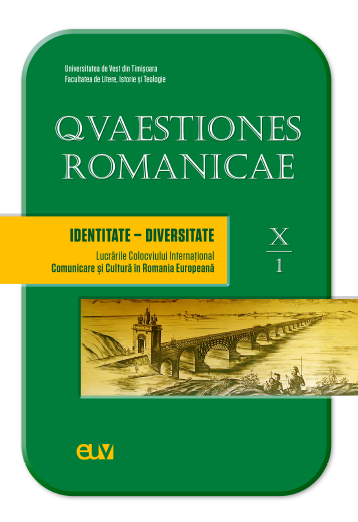Migranți sau refugiați? Construcții identitare prin opțiuni semantice în presa locală online timișoreană
Abstract: (Migrants, refugees or fugitives? Constructing identities via semantic options in the online media from Timişoara) Mass-media represents a major factor in shaping perceptions. Hence, the semantic choices undertaken by journalists when presenting certain social groups can be very influential in constructing the identity of those groups in the eyes of the audiences. Naming the displaced persons who cross the border into Romania (whether in transit toward Western Europe or for a longer stay in the country) as „migrants”, „refugees”, „asylum seekers” or „immigrants” contributes to the way in which they are perceived by the local community. The current study aims to analyze how the identity of these persons is mediated by one of the most influential online local media outlet via the semantic choices of journalists, as well as what are the dominant media frames in which they are presented to the audiences. Following a review of the context of migration in/through Romania and of the two groups of displaced persons who currently appear in the local media from Timişoara (the „older” one, from outside Europe, and, starting with 2022, the one from Ukraine) and of some of the most frequently used terms in the semantic sphere of migration, the current study uses the methodological tools of media framing theory for analyzing articles on the topic published during one month on Tion.ro, one of the most widely read local news platforms in Timişoara. The results of the analysis bring into discussion the connection between the semantic choices and the identified dominant media frames, while also establishing wider links between these elements and the larger context of journalistic practice in the online local media.
Keywords: migration, semantics of migration, local online press, media framing theory, journalistic practices.
Rezumat: Mass-media reprezintă un factor extrem de influent în modelarea percepţiilor, iar opţiunile semantice ale jurnaliştilor în prezentarea anumitor grupuri sociale pot fi definitorii pentru construirea identităţii acestora în ochii audienţelor. Denumirea persoanelor strămutate care vin în România (în tranzit către Europa occidentală sau pentru o şedere de durată aici) drept „migranţi”, „refugiaţi”, „azilanţi” sau „imigranţi” contribuie la felul în care ele sunt percepute de comunitatea locală. Lucrarea de faţă îşi propune să analizeze cum e mediată identitatea acestor persoane de către unul dintre cele mai influente canale mediatice locale online prin opţiunile semantice ale jurnaliştilor, precum şi care sunt cadrele mediatice dominante folosite pentru reprezentarea acestora în ochii audienţelor. După o trecere în revistă a contextului actual al migraţiei în/prin România şi a celor două grupuri de persoane strămutate ce se află în vizorul presei locale timişorene (cel „mai vechi”, din afara Europei şi, din 2022, cel din Ucraina), precum şi a câtorva dintre cei mai uzitaţi termeni din sfera semantică a migraţiei, studiul de faţă foloseşte uneltele metodologice ale teoriei cadrajului mediatic pentru a realiza analiza textuală a articolelor publicate în decursul unei luni pe Tion.ro, una dintre platformele de ştiri cu audienţă semnificativă pe plan local. Rezultatele studiului aduc în discuţie conexiunea dintre opţiunile semantice şi stabilirea cadrului mediatic dominant, identificând totodată legătura acestor elemente cu contextul mai larg al unor practici jurnalistice specifice presei locale online actuale.
Cuvinte-cheie: migraţie, semantica migraţiei, presă locală online, teoria cadrajului mediatic, practici jurnalistice.
